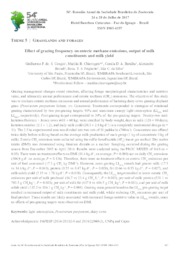Effect of grazing frequency on enteric methane emissions, output of milk constituents and milk yield.
Effect of grazing frequency on enteric methane emissions, output of milk constituents and milk yield.
Author(s): CONGIO, G. F. S.; CHIAVEGATO, M. B.; BATALHA, C. D. A.; BERNDT, A.; FRIGHETTO, R. T. S.; SILVA, S. C. da
Summary: Grazing management changes sward structure, affecting forage morphological characteristics and nutritive value, and ultimately animal performance and enteric methane (CH4) emissions. The objective of this study was to evaluate enteric methane emissions and animal performance of lactating dairy cows grazing elephant grass (Pennisetum purpureum Schum. cv. Cameroon). Treatments corresponded to strategies of rotational grazing characterized by two pre-grazing targets; 95% and maximum canopy light interception (LI95% and LIMax, respectively). Post-grazing target corresponded to 50% of the pre-grazing targets. Twenty-two midlactation Holstein × Jersey cows (488 ± 60 kg) were stratified by body weight, days in milk (126 ± 90 days), lactation number (2.3 ± 1.2), and daily milk yield (20.3 ± 2.6 kg d-1) in a completely randomized design (n = 11). The 2.5 ha experimental area was divided into two sets of 18 paddocks (700 m2). Concentrate was offered twice daily before milking based on the average milk production of each group (1 kg of concentrate:3 kg of milk). Enteric CH4 emissions were collected using the sulfur hexafluoride (SF6) tracer gas method. Dry matter intake (DMI) was determined using titanium dioxide as a marker. Sampling occurred during the grazing season from December 2015 to April 2016. Results were analyzed using the PROC MIXED of SAS (? = 0.05). There were no treatment effects on DMI (18.4 kg d-1, on average; P = 0.090) nor on daily CH4 emissions (304.9 g d-1 on average; P = 0.136). Therefore, there were no treatment effects on enteric CH4 emissions per unit of feed consumed (17.3 g CH4 kg DMI-1). However, cows grazing LI95% swards had greater milk (17.5 vs 14.6 kg d-1; P = 0.043), protein (0.55 vs 0.47 kg d-1; P = 0.029), fat (0.66 vs 0.55 kg d-1; P = 0.027), and milk solids yield (2.15 vs 1.79 kg d-1; P = 0.019). Consequently, the LI95% target resulted in lower enteric CH4 emissions per unit of milk produced (16.7 vs 23.4 g CH4 L-1, P = 0.002), per unit of milk protein (528.1 vs 703.5 g CH4 kg-1; P = 0.003), per unit of milk fat (437.9 vs 606.5 g CH4 kg-1; P = 0.001), and per unit of milk solids yield (135.2 vs 186.1 g CH4 kg-1; P = 0.001). Grazing management based on the LI95% pre-grazing target resulted in increased output of milk constituents and milk yield, whilst reducing CH4 emissions per unit of final product. These results are likely associated with increased forage nutritive value in LI95% swards, since no effects of pre-grazing targets were observed on DMI.
Publication year: 2018
Types of publication: Abstract in annals or event proceedings
Unit: Embrapa Environment
Keywords: Dairy cows, Emissions, Light interception, Metano, Methane, Pennisetum, Pennisetum Purpureum, Vaca Leiteira
Observation
Some of Embrapa's publications are published as ePub files. To read them, use or download one of the following free software options to your computer or mobile device. Android: Google Play Books; IOS: iBooks; Windows and Linux: Calibre.
Access other publications
Access the Agricultural Research Database (BDPA) to consult Embrapa's full library collection and records.
Visit Embrapa Bookstore to purchase books and other publications sold by Embrapa.

